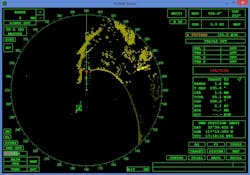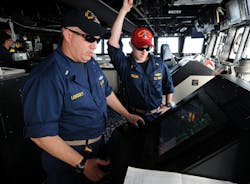Ultra Electronics to start production on software-defined radar for navigation aboard Navy surface warships
PORT HUENEME, Calif. – U.S. Navy Surface warship radar experts are asking the Ultra Electronics Ocean Systems segment in Braintree, Mass., to build a new software-defined surface-search radar system to replace existing radars that suffer from obsolescent technologies or an inability to meet current threats.
Officials of the Naval Surface Warfare Center Port Hueneme Division at Port Hueneme, Calif., announced a $42.2 million order to Ultra Electronic Ocean Systems on Tuesday to produce the Next Generation Surface Search Radar (NGSSR).
Navigation and situational awareness are basic functions of all surface warships and these seemingly routine tasks have become more difficult as the ocean becomes increasingly complex with the proliferation of inexpensive solid-state radar, Navy officials say. In March 2019 Ultra Electronics won a $28 million contract to develop NGSSR qualification systems.
Major shipping channels are jammed with ship and radio traffic as well as debris like floating transport containers. Even small fishing boat and pleasure craft operators today can afford navigation radar systems. Air traffic and land-based radar further crowd and confuse the radio spectrum.
This contract modification to Ultra Electronics will acquire the first NGSSR production lot following a contract award for design and production of three qualification systems.
To make matters worse, enemy ships, aircraft, and unmanned aerial vehicles (UAVs) can exploit this complex sensor picture to conduct surveillance or other operations undetected. The answer, experts say, will be the NGSSR.
This new radar uses of the latest digital technology and incorporate a software-based architecture at its core. NGSSR will have a suite of algorithms that extend, enhance, and optimize NGSSR's performance by exploiting the system's software-defined architecture.
The NGSSR's receiver and exciter are implemented in software to the maximum extent possible, Navy officials say. The bulk of the non-processor hardware is for A/D and D/A conversion, except for ancillary equipment like power supplies. Its software-defined capabilities are expected to enhance maintainability by reducing radar-specific hardware.
Its software-defined architecture also could implement functionality never before considered for such relatively simple rotating radar, such as extending the radar’s range and navigation functions in bad weather; resisting enemy electronic warfare attempts to jam it; detecting UAVs, periscopes, floating debris, and floating mines; and improving collision avoidance in crowded waterways.
The new NGSSR software-defined radar ultimately will replace all variants of the Navy's current AN/SPS-67, AN/SPS-73, BridgeMaster E series, and commercial-of-the-shelf radar systems.
Ultra Electronics is helping to find a replacement for legacy systems due to current military threats and obsolescence issues. Last year the company outlined the requirements and approach for NGSSR development, testing, and manufacturing.
Related: New communications for Navy ships based on software-defined radio
The AN/SPS-67 is a short-range, two-dimensional, surface-search and navigation radar system that provides surface and limited low-flyer detection and tracking. the AN/SPS-73(V)12 radar, likewise, is a short-range, two-dimensional, surface search and navigation radar system that provides contact range and bearing information, and helps determine own-ship position relative to nearby vessels and navigational hazards. The BridgeMaster E surface- search radar, meanwhile, provides navigation to commercial and military high speed crafts and vessels.
The AN/SPS-73(V)12 is installed on about 100 Navy ships like aircraft carriers, cruisers, destroyers, amphibious assault ships, and support ships. It was placed into caretaker Status in 2017 in preparation for its replacement by the NGSSR. Thousands of BridgeMaster E marine radars, meanwhile, have been sold to more than 50 navies and coast guards worldwide as well as civilian customers. It replaced the Navy SPS-64 surface-search radar on Arleigh Burke-class destroyers in 2001.
On this order Ultra Electronics Ocean Systems will do the work in Wake Forest, N.C.; Chantilly, Va.; and Braintree, Mass., and should be finished by April 2023. For more information contact Ultra Electronic Ocean Systems online at www.ultra-electronics.com/os, or the Naval Surface Warfare Center Port Hueneme Division at www.navsea.navy.mil/Home/Warfare-Centers/NSWC-Port-Hueneme.

John Keller | Editor-in-Chief
John Keller is the Editor-in-Chief, Military & Aerospace Electronics Magazine--provides extensive coverage and analysis of enabling electronics and optoelectronic technologies in military, space and commercial aviation applications. John has been a member of the Military & Aerospace Electronics staff since 1989 and chief editor since 1995.


